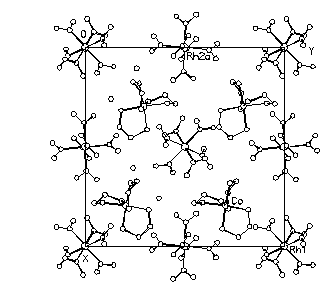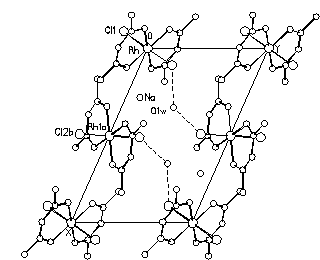

'CLOSEST PACKINGS' LAW IN CRYSTAL STRUCTURES OF NEW Rh(III) COMPLEXES. N.V. Podberezskaya, G.V. Romanenko, Institute of Inorganic Chemistry Sib. Branch RAS, Novosibirsk, Russia
Crystal structures of two novel coordination Rh(III) compounds were determined (SYNTEX P21, MoK, /2-scan, 3deg.250) : cubic [Co(en)3][Rh(NO2)6]*3H2O, en=C2H8N2 (I) (a=16.540(5) Å, V=4525(2) Å3, Pa3, Z=8, Dc=1.974 g[[dotaccent]]cm-3, 589 unique Ihkl > 2I, R=0.0905) and triclinic Na[Rh(acac)2Cl2]*H2O, acac=C5H7O2- (II) (a = 12.616(6), b = 8.411(4), c = 8.499(4) Å, (=108.37(4), (= 95.47(4), (= 110.45(4)[[ordmasculine]], V = 780.3 Å3, P1(-), Z = 2, Dc=1.758 g[[dotaccent]]cm-3, 1200 unique Ihkl >2I, R=0.0463). In I, the joint packing of the complex cations, anions and water molecules presents the stacking after the three-layered closest packing with the combination of NaCl and CaF2 structure types; in II, the complex anions produce the stacking after the hexagonal closest packing with Na+ and H2O located in its cavities. The presence of organic ligands in the composition of the complexes does not contradict our understanding of packing rules for inorganic coordination compounds in the description of complex cations and anions as the quasi-spheric particles of the Ref radius.


I II